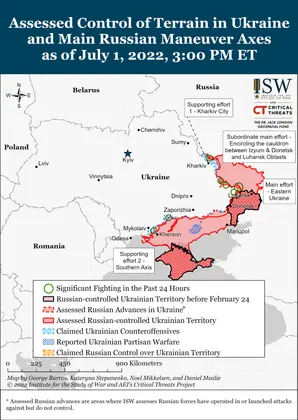- Russian forces continued efforts to encircle Lysychansk and conducted offensive operations to the south and southwest of the city.
- Russian forces have likely not yet reached the T1302 Bakhmut-Lysychansk highway on the ground but are denying Ukrainian forces use of it by continuing artillery and airstrikes against remaining Ukrainian positions along the road.
- Russian forces focused on regrouping and improving their tactical positions north of Slovyansk.
- Russian forces did not conduct any confirmed ground assaults in northern Kharkiv Oblast and continued shelling Ukrainian positions north of Kharkiv City.
- Russian forces conducted artillery and missile strikes along the Southern Axis.
- Russian authorities continue efforts to expand the pool of recruits available to fight in Ukraine.
The Kremlin is likely setting conditions for crypto-mobilization of the Russian economy in preparation for a protracted war in Ukraine.
The Kremlin proposed an amendment to federal laws on Russian Armed Forces supply matters to the Russian State Duma on June 30, that would introduce “special measures in the economic sphere” obliging Russian businesses (regardless of ownership) to supply Russian special military and counterterrorist operations.[1] The amendment would prohibit Russian businesses from refusing to accept state orders for special military operations and allow the Kremlin to change employee contracts and work conditions, such as forcing workers to work during the night or federal holidays. The Kremlin noted in the amendment’s description that the ongoing special military operation in Ukraine exposed supply shortages, specifically materials needed to repair military equipment, and stated that Russian officials need to “concentrate their efforts in certain sectors of the economy.” Russian President Vladimir Putin is likely mobilizing the Russian economy and industry to sustain the ongoing war effort, but has not yet taken parallel measures to mobilize Russian manpower on a large scale.
JOIN US ON TELEGRAM
Follow our coverage of the war on the @Kyivpost_official.
Russian authorities are likely taking measures to integrate the Zaporizhzhia Nuclear Power Plant (NPP) directly into the Russian energy system, contradicting previous Russian statements that the Zaporizhzhia NPP would sell electricity to Ukraine.

Latest US Aid Package for Ukraine Probably Includes ADAM Anti-Personnel Mines
Olga Kosharna, an independent expert on nuclear energy, stated on June 30 that Russia’s Rosatom (Russian state-owned nuclear energy corporation) employees have been taking measures at the Zaporizhzhia NPP to potentially divert its energy to the Russian energy grid.[2] Kosharna added that Russian forces have been working in Chonhard (southern Kherson Oblast) to repair the main energy transmission line that runs into Crimea, which Ukrainian forces had destroyed in 2015 following Russia’s seizure of the transmission line after the annexation of Crimea in 2014. Representatives of Ukraine’s Ukrenergo electricity transmission operator had stated as recently as late May that it would be physically impossible for Russia to divert Ukrainian electricity to Russia following the destruction of those transmission lines.[3] Russian forces are likely seeking to ensure physical access to transmission lines in order to support the direct flow of Ukrainian energy into Russia, which may explain some of the military activities observed in recent weeks in the Russian-occupied portions of Zaporizhia Oblast. Russian authorities had indicated on May 18 that while the Zaporizhzhia NPP would work for Russia, it would continue to sell energy to Ukraine, as ISW reported.[4] However, it is becoming increasingly evident that Russian authorities are taking measures to integrate Ukrainian economic assets directly into the Russian economy. Reports that Russian forces may be preparing a false flag provocation at the Zaporizhzhia NPP could be part of this Russian effort–Moscow might use such a false flag attack to accuse Ukrainian authorities of mismanaging nuclear assets and justify taking full control of them and their output.[5]
Authors Kateryna Stepanenko, Karolina Hird, Frederick W. Kagan, and George Barros
See full report here
You can also highlight the text and press Ctrl + Enter






